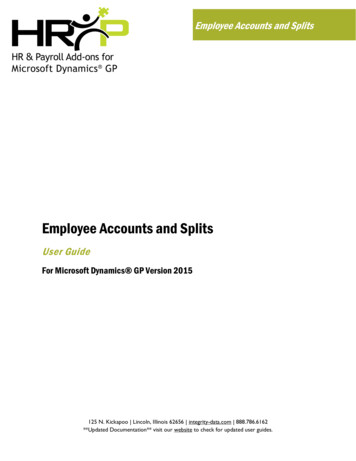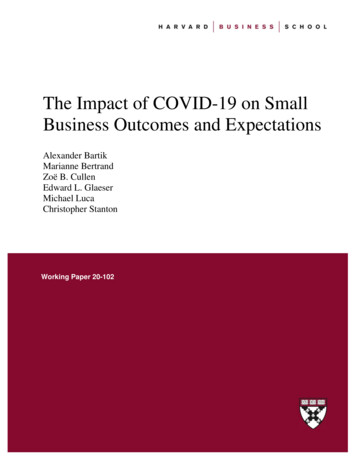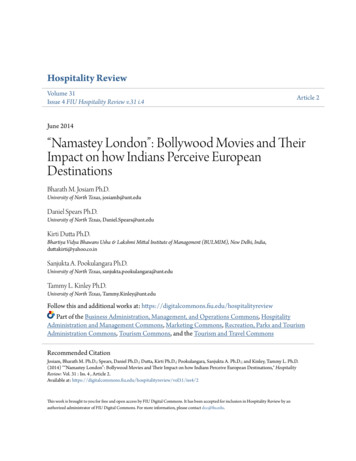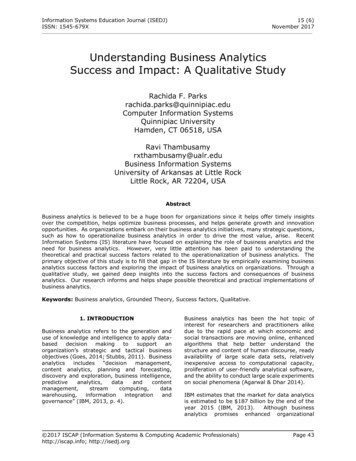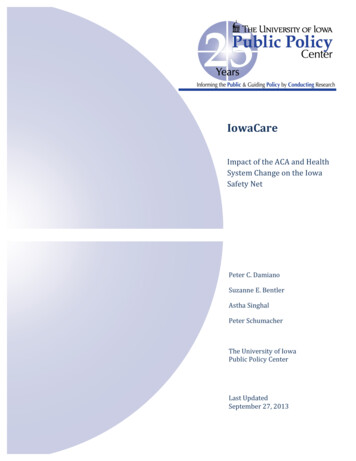
Transcription
enterLastUpdatedSeptember27,2013
IntroductionThis is a report that inventories all the information we have collected on the funding, patients,providers, and services of the IowaCare program. This information was collected as part of a studyfunded by The Commonwealth Fund to study the implications of the Affordable Care Act (ACA) on safetynet health care providers.The IowaCare program is a limited-benefit, public health insurance program for adults in Iowa up to 200percent of the federal poverty level (“FPL”). It was authorized by Iowa House File 841 under a Medicaidexpansion program and approved on July 1, 2005. This program covers some inpatient and outpatientservices, physician, and advanced registered nurse practitioner services, limited dental services, routineyearly physicals, smoking cessation, and limited prescription drug benefits.1The program was modified by the Iowa legislature so that on October 1, 2010, an IowaCare MedicalHome pilot was started to, in part, prepare for the influx of new Medicaid enrollees in 2014 resultingfrom the health insurance expansion component of the Patient Protection and Affordable Care Act(“ACA”). At that time, all Iowa residents up to 133 percent of the FPL will be eligible for the Medicaidprogram.1 In 2010, the Iowa Legislature passed Senate File 2356 that authorized the expansion of theprovider network to include a regional primary care provider network, beginning with an approach tophase-in Federally Qualified Health Centers (FQHCs).The bill mandated that the selected FQHCs provide primary health care services to the IowaCarepopulation and to comply with certification requirements of a medical home. The first step was theestablishment of 3-4 medical home sites consisting of UIHC in Iowa City, Broadlawns in Des Moines, andtwo FQHCs effective October 1, 2010. Siouxland Community Health Center in Sioux City was chosen toserve IowaCare members in twelve counties and Peoples Community Health Clinic, Inc. (PCHC) inWaterloo was chosen to serve members in fourteen counties.2On July 1, 2011, three more FQHCs were added as medical home sites to provide services to theIowaCare members being transitioned from PCHC in Waterloo: Community Health Center of Fort Dodge (CHCFD) – Began providing services to members in fivecounties: Cerro Gordo, Floyd, Franklin, Mitchell, and Worth.Crescent Community Health Center in Dubuque (CCHC) – Began providing services to membersin four counties: Chickasaw, Fayette, Howard, and Winneshiek Counties.Primary Health Care Inc. in Marshalltown (PHC) – Began providing services to members inGrundy County.2While a plan was being developed to address the capacity issues at PCHC in Waterloo, at the same timeBroadlawns in Des Moines and UIHC in Iowa City proposed a new Regional Model. The Regional Model,which was ultimately adopted beginning October 1, 2011, divided the state into five geographic areasthat would be served by six FQHCs, Broadlawns, and UIHC. The plan expanded Broadlawns’ role tobecome a medical home site for IowaCare members in Region 5 and a regional primary care hospital formembers in Regions 3, 4, and 5. The plan also expanded UIHC’s role to serve as a medical home site and
regional hospital in Regions 1 and 2 and to provide specialty care to IowaCare members statewide. UIHCalso opened satellite offices in Belle Plain, Lowden, Riverside, Muscatine, and Wapello to IowaCaremembers. All Care Health Center in Council Bluffs (ACHC) was added as a medical home site for thesouthwestern region of the state on November 1, 2011.2All IowaCare members that had not yet been assigned to a medical home site as of January 1, 2012 wereassigned to one of the above sites based on their county of residence. The medical home sites areexpected to provide routine care, preventive services, and disease management, while referringmembers needing specialty or hospital care to UIHC in Iowa City or Broadlawns in Des Moines.2The IowaCare 1115 waiver will expire on December 31, 2013. As of June 2013, the Iowa Legislaturepassed the Iowa Health and Wellness Plan that will provide coverage to existing IowaCare membersthrough a combination of an expansion of Medicaid with a slightly different benefit package, based onthat of Iowa State Employees, and the purchase of subsidized insurance on the forthcoming HealthInsurance Exchanges.2IowaCare’s eligibility includes: Persons 19 through 64 years old with a net income equal to, or below, 200 percent of the FPLwho are not otherwise eligible for Medicaid; Pregnant women (regardless of age) and women with newborn children, if the woman’s netincome is less than 300 percent of the FPL after medical bill deductions that reduce the familyincome to 200 percent, or less, of the FPL.1Individuals enrolled in another group health insurance are not eligible for IowaCare. However, anindividual is not considered to have access if coverage under another group health plan is unaffordable,excludes certain pre-existing medical conditions, or does not cover needed services. Therefore, limitedsituations exist when an individual may be enrolled in both IowaCare and another group health.Eligibility in IowaCare extends for a 12-month period. IowaCare members with income equal to, orbelow, 100 percent of the FPL do not pay a monthly premium. IowaCare members with income less than150 percent of the FPL pay a monthly premium based on a sliding fee scale, which is calculated based on3.5 percent of the lowest applicable income level. Monthly premiums for IowaCare members range from 50 to 85.1FinancingIowaCare Account: All State appropriations needed to fund medical services provided by IowaCare areincluded in the IowaCare Account appropriations in House File 841. All payments for medical services toproviders flow through the IowaCare Account. The administrative costs and appropriations to designand implement future phases of the Act are funded from the Health Care Transformation Account.
State and Federal Match sources: The IowaCare Program is supported from a mix of funding sourcesincluding state general funds, Polk County tax revenues, certified public expenditures (CPE) at theUniversity of Iowa, premiums paid by members, other state funds (Health Care TransformationAccount), and federal matching funds through the Federal Medical Assistance Percentage (FMAP). Thetotal budget for SFY13 was 160 million: 8.7 million (5.4%) is state general fund 95.29 million (59.6%) is federal funding 55.79 million (34.9%) is other funding:o 42 million is from Polk County tax revenue ando Approximately 13 million is from the University of Iowa CPE.3Health Care Transformation Account: The Health Care Transformation Account is funded with thefederal share of payments obtained under State Plan Amendments (SPA’s) 03-017 and 04-007 and withrevenue generated through payment of premiums by expansion population members. The premiuminformation is addressed in more detail in the premium section of these documents. SPA 03-017provides for supplemental payments for physician services at publicly owned acute care teachinghospitals for the time period of July 1, 2003 through June 30, 2005. SPA 04-007 provides for high costadjustment payments for state owned hospitals with over 500 beds for the time period of July 1, 2004through June 30, 2005. The amount of funding anticipated to be leveraged from these SPA’s isapproximately 38.5 million.Provider NetworkThe network includes2: Broadlawns Medical Center (Broadlawns) in Des Moines, IowaThe University of Iowa Hospitals and Clinics (UIHC) in Iowa City, IowaSiouxland Community Health Center in Sioux City, IowaPeoples Community Health Clinic in Waterloo, IowaCommunity Health Center of Fort Dodge (CHCFD) in Fort Dodge, IowaCrescent Community Health Center in Dubuque, IowaAll Care Health Center in Council Bluffs, IowaPrimary Health Care (PHC) in Marshalltown, IowaA map of the counties participating in the medical home demonstration is shown in Figure 1.
Figure 1. IowaCare Medical Home DesignationsServices CoveredIowaCare provides coverage for most inpatient and outpatient services. Some limited coverage is alsoavailable for other services such as2:Preventive visits: A preventive health visit assesses overall health and health behaviors that promote anindividual’s wellbeing. The primary focus is on the prevention and early detection of disease. Preventivehealth visits are now covered under IowaCare. An annual physical examination must be provided by themember’s assigned medical home. If additional services or follow-up care is indicated as a result of theannual physical, an approved IowaCare provider must perform these services.2Durable medical equipment: IowaCare provides a very limited Durable Medical Equipment benefit. UIHCprovides some additional durable medical equipment to IowaCare enrollees on a case-by-case basis.2Dental: IowaCare covers only limited dental services, including extractions at IowaCare providers. Morecomprehensive dental care is available at BMC in Des Moines for residents of Polk County.2Transportation: IowaCare does not cover transportation services. However, a transportation service wasprovided by UIHC in Iowa City to help IowaCare members travel from their homes to UIHC and back. This
transportation service was available by appointment only and members called to scheduletransportation. IowaCare did not cover lodging and meal costs that resulted from overnight stays atUIHC. UIHC ended this transportation service to IowaCare patients on December 31, 2012.During the 4th quarter of SFY12, the Department of Transportation (DOT) secured a grant of 50,000 toassist IowaCare members with transportation for medical care and pharmacy visits. The funds becameavailable for access on April 1, 2012. However, DOT notified the state that funds were expected to runout as early as September 2012; therefore, they would have to terminate the program on October 1,2012. The program was replaced with a similar system, but the new funding limits coverage to 80percent of transportation costs per trip, and the number of participating transit agencies decreasedfrom 16 to 8.2Prescriptions: Although IowaCare does not have a prescription drug benefit, there are some prescriptiondrugs provided by both UIHC and Broadlawns. For example, patients in the UIHC medical home mayreceive up to a 60-day supply of some generic prescription medicine for a 4 copayment with multiplerefills. And, they provide a 10-day supply of any prescriptions associated with an inpatient or outpatientDRG. Some medication administered in the hospital outpatient clinic is also provided. Broadlawnsprovides some limited medications through its community care program. There is also a volunteer drugprogram from which some members can receive prescription medications.The 2011 Iowa General Assembly passed House File 649 to establish a 4 million pool for IowaCaremembers receiving outpatient prescription drugs, podiatry and optometry services at BroadlawnsMedical Center (region 5 members only). This pool was approved by CMS for utilization on November 1,2011. The 2012 Iowa General Assembly reauthorized utilization of this pool for SFY 2013.IowaCare members are eligible for the same tobacco cessation benefit as Medicaid members wherethey can access cessation counseling through Quitline Iowa and receive pharmacotherapy prescribed bytheir primary care provider.All of the IowaCare providers also work to assist members with their prescription needs by making 340Bdrug prices available (reduced costs are based on a sliding fee schedule), helping to them enroll inPrescription or Medication Assistance Programs offered by pharmaceutical manufacturers, andconnecting them with the various pharmaceutical access programs administered by the IowaPrescription Drug Corporation Program.2Emergency Services: In SFY 2010, Senate File 2356 authorized an additional 2 million in funds to beaccessible for non-IowaCare hospitals to pay for emergency services that result in an inpatientstay. These funds were made available beginning October 1, 2010. However, hospitals reported that theadministrative requirements presented a barrier to accessing the funds. As a result, the Iowa MedicaidEnterprise (IME) proposed a statutory change to ease these restrictions. The Iowa legislature supportedthe bill, Administrative Rules were adopted, and these went into effect on September 1, 2011, duringthe first quarter of SFY 2012. The 2012 Iowa General Assembly reauthorized this pool for SFY 2013.2
Newer Services: The 2011 Iowa General Assembly also passed Senate File 313 that authorized additionalexpansion items. CMS approved these expansion items for utilization under the IowaCare Safety NetCare Pool (I-SCNP). The following I-SCNP funds were effective November 1, 2011: Laboratory & Radiology Services – I-SCNP funds provide up to 500,000 to help defray the costof laboratory and radiology services for FQHCs that do not have on-site capability to providethese services to IowaCare members.Care Coordination Services – I-SCNP funds provide up to 1.5 million to help defray the cost of noncovered services necessary to provide continuation of care following an inpatient stay at UIHC in IowaCity or BMC in Des Moines. Funding is limited to durable medical equipment, home health care, andrehabilitation and therapy services.2
Population ServedEnrollment in the IowaCare program has grown rapidly, especially in the last five years as shown belowin Figure 22:IowaCare 0010,0000SFY 2009SFY 2010SFY 2011SFY 2012SFY 2013(est)Figure 2. IowaCare enrollment SFY09-SFY13 (Data courtesy of the Iowa Department of Human Services)Race/ethnicity of the IowaCare enrollees is shown in Figure 3:Figure 3. Race/ethnicity of IowaCare enrolleesWhen compared to the adult Medicaid and general Iowa population, they were more likely to be nonwhite than the general Iowa population but very similar to the adult Medicaid population. Eighty-sixpercent of IowaCare enrollees reported their race/ethnicity to be white compared to 89% of the generalIowa population and 82% in the most recent survey of Medicaid enrollees2.
IowaCare enrollees were significantly more likely to be male than adults in the Medicaid program (45%vs. 18%)2.Regarding educational attainment, 45% of IowaCare enrollees had some college education, with 1 in 9being 4-year college graduates or higher. Overall, IowaCare enrollees had similar education levels as theadult Medicaid population, with 48% having attended some college2.References1. Damiano PC, Willard JC, Momany ET, Park K, Skemp E, Carter K. (2011). Evaluation of the IowaCareProgram: Baseline Information for the Medical Home Expansion. The Public Policy Center: Iowa City,IA.2. Damiano PC, Bentler SE, Momany ET, Park K, Robinson E. (2013). Evaluation of the IowaCareProgram: Information about the Medical Home Expansion. The Public Policy Center: Iowa City, IA.3. IowaCare Fact Sheet. (2013). Available at the State of Iowa Department of Human Services site:http://www.dhs.state.ia.us/uploads/IowaCare Narrative.pdf Accessed September 1, 2013.
For example, patients in the UIHC medical home may receive up to a 60 -day supply of some generic prescription medicine for a 4 copayment with multiple refills. And, they provide a 10-day supply of any prescriptions associated with an inpatient or outpatient DRG. Some medication administered in the hosp
